12 Most Common Types of Butterflies in New York (With Pictures)
-
Pete Ortiz
- Last updated:
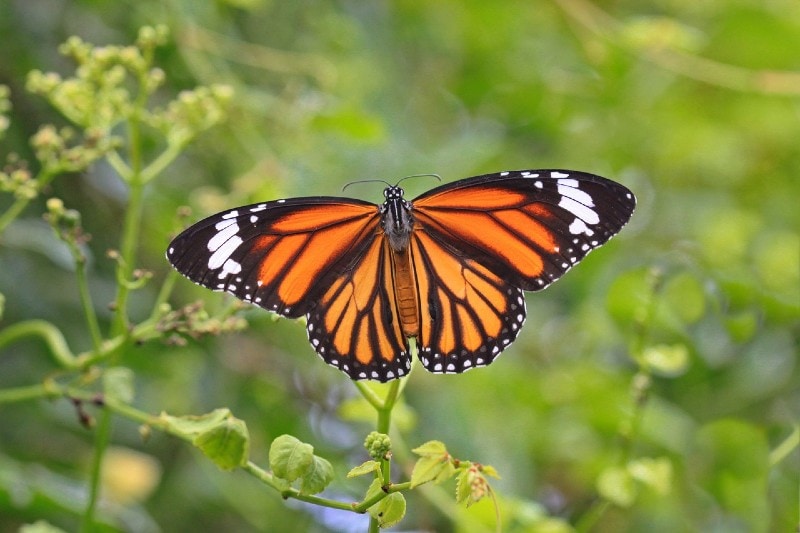
Here’s a beautiful fact: New York is full of tall buildings and concrete paths, but you will be shocked by the vast number of butterflies in the city. In fact, there’s more to these butterflies than meets the eye. Some are native to New York and cannot be found anywhere else.
If you find butterflies fascinating, you will love that there are plenty in the city, and while it might be a bit tough to tell them apart, knowing some key features to look out for might help. Here are a few ways to tell them apart:
How to Identify Different Types of Butterflies
It’s amazing how two butterflies can look so similar but are different. Sometimes it’s even difficult to tell between butterflies and moths!
Well, one of the easiest ways to differentiate between a moth and a butterfly is by looking at the antennae. Typically, butterflies have club-shaped antennae with a bulb at the end, while moth’s antennae are feathery, saw-edged.
The best way to enjoy butterfly-watching is by determining the type of butterflies you are looking at. Well, you can distinguish the different butterflies by looking at their color, size, and habitats. If you’re not sure where to start, we’ve got you covered.
The 12 Common Butterfly Types in New York
There are multiple types of butterflies in New York, but the most common ones are:
1. Red Admiral
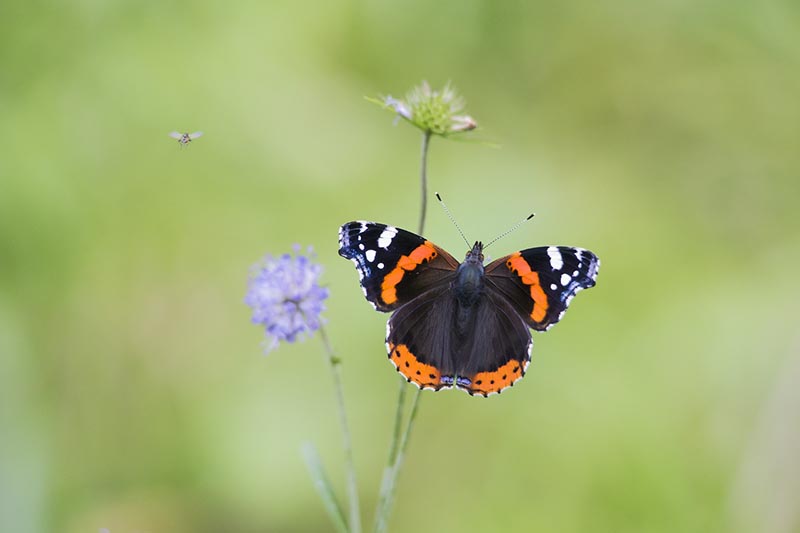
| Color | Dark brown with reddish circular bands and white spots |
| Size | A wingspan of 1.75 to 2.5 inches |
| Habitat | Moist habitats near forest edges |
The red admiral is a migratory butterfly usually found in New York during summer. They are plenty around and are easy to observe since they have unique and distinct features. For starters, the caterpillars are pinkish gray and have small spikes along their back.
Red admirals are also very easy to approach since they are not fearful of humans; they even land on people. To attract this butterfly to your garden, you should leave out fermented fruit in your yard.
2. Monarch Butterfly

| Color | Have a stained glass coloring with an orange and black veined pattern
Have white dots lines along the edges of the wing |
| Size | A wingspan of 3.5 to 4 inches |
| Habitat | Anywhere there is milkweed |
The monarch butterfly is the most common type of butterfly in New York. They are mainly famous for their pattern and migratory patterns.
The caterpillars are plump, have black, white, and yellow bands, and have tentacles on each end of their bodies. Unfortunately, the monarch butterfly population has been declining over the past decade.
One of the ways you can help boost their numbers is by planting milkweed in your yard.
3. Viceroy Butterfly

| Color | Deep orange/ greenish-brown coloring with black edges and white spots on the black border. |
| Size | A wingspan of 2.5 to 3.25 inches |
| Habitat | On leaves of plants |
Viceroy butterflies closely resemble monarch butterflies; the only difference is that they do not migrate. Unlike monarch butterflies, they also have a black line on the bottom wing. Their caterpillars are greenish-brown and have small spines on their bodies.
These butterflies hibernate by rolling up in the leaves of plants during winter instead of migrating. You can find them in bushy areas.
4. White Admiral
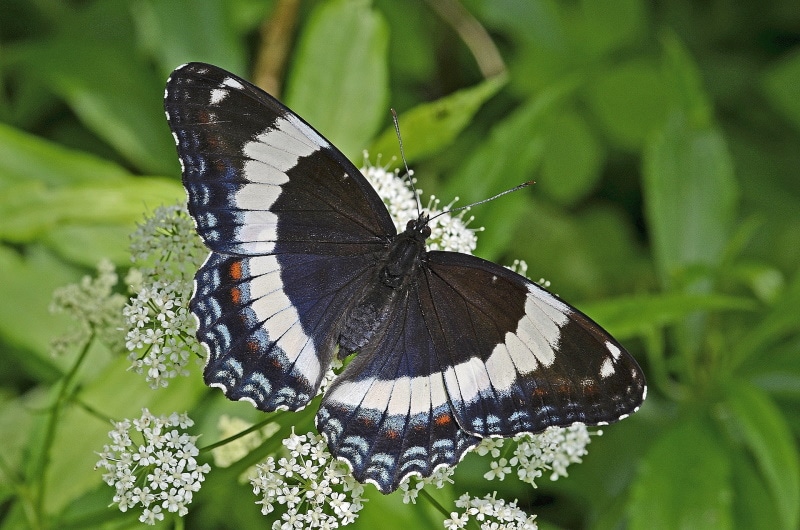
| Color | Black with white bands at the center of the upper wings |
| Size | A wingspan of 3 to 4 inches |
| Habitat | Willow, aspen, and birch trees |
White admirals can mimic other butterflies, which makes them difficult to identify. Their caterpillars have a molten-blown, yellow body with lumpy spines on their back and two small horns.
These butterflies are active in New York from April to October, which is their mating season. They are easy to identify because of the tiny intricate markings on the underside of the wings.
5. Red-Spotted Purple

| Color | Iridescent blackish-blue coloring with spots on the outer edge of the wing |
| Size | A wingspan of 3 to 4 inches |
| Habitat | Bushes, moist environments |
Red-spotted purple butterflies are one of the most beautiful butterflies in New York. Their bright bluish, red, and orange hues help them stand out. This bright coloring also acts as a defense mechanism against predators.
The red-spotted purple is similar to the white Admiral in that it can mimic other butterflies. Their mating season is between April to October when they are most active. They also feed on rotting fruit and sap instead of nectar, and butterflies of these species often look quite different.
6. Mourning Cloak
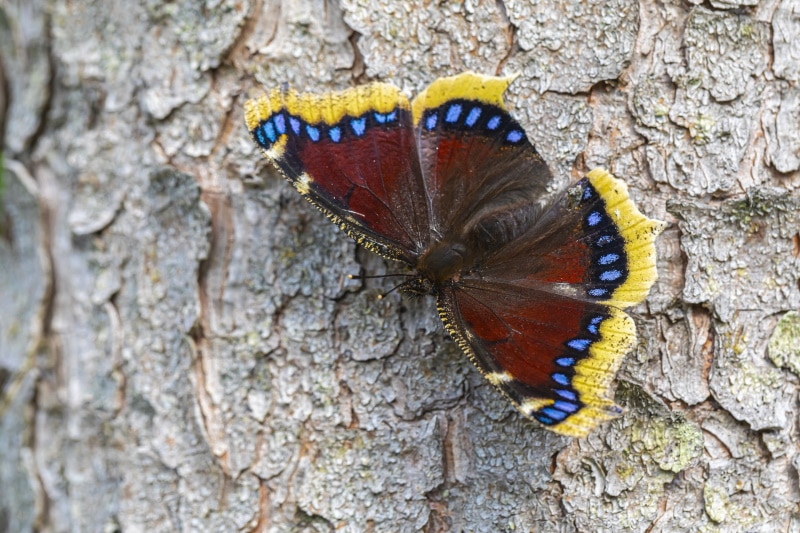
| Color | Black with a bright sheen. They also have a yellow border with a row of purple spots on the outer part of the wing. |
| Size | A wingspan of 3 to 4 inches |
| Habitat | Deciduous forests |
The mourning cloak butterflies are common in New York during spring and winter. They mostly prefer the cold and live in solitary habitats, which makes them extremely difficult to spot. These butterflies are masters of camouflage and will fold their wings into their bodies, making them easy to miss.
Mourning cloak butterflies have a longer lifespan than most butterflies and can live for ten months or more. The caterpillars are black with white spots on their back.
7. Pearl Crescent
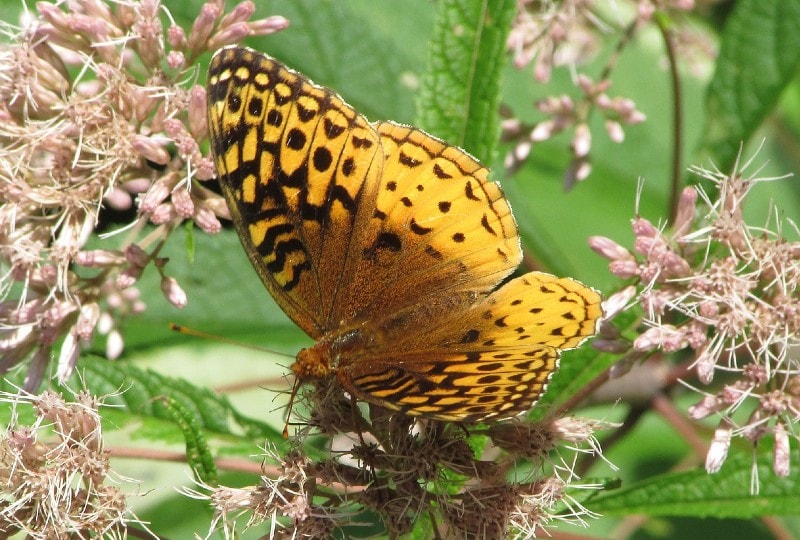
| Color | Bright orange coloring with black borders, spots, and lines |
| Size | A wingspan of 1.25 to 1.75 inches |
| Habitat | Open, sunny habitats |
The pearl crescent is pretty easy to identify. It’s also unique in that the butterfly looks like a caterpillar. You can find them in open fields with the aster plant. However, any flowering plants will attract this butterfly since they feed on nectar.
8. Question Mark Butterfly
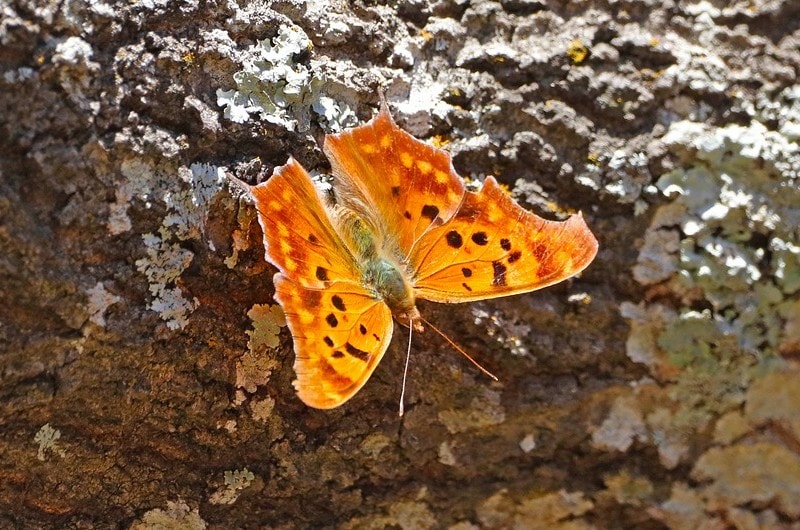
| Color | Deep orange coloring with black spots and purple edges |
| Size | A wingspan of 2.25 to 3 inches |
| Habitat | Woodlands |
The question mark butterfly closely resembles the pearl crescent butterfly. You can find them in overly bushy environments because they prefer to lay their eggs on elm and nettle trees where the larvae can hatch.
They have a deep orange color that resembles that of dead, wilted leaves, which helps them avoid predators. Their markings look like a question mark which is where they get their name from.
9. Eastern Comma
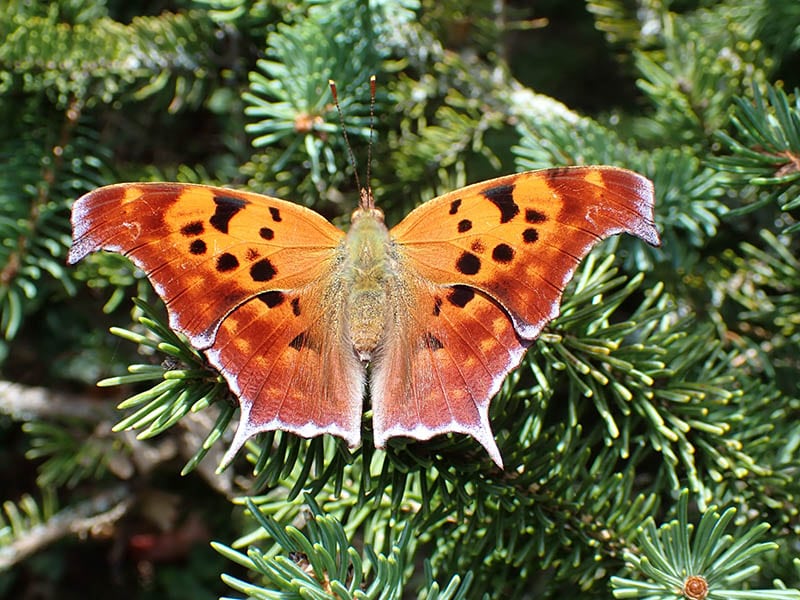
| Color | Orange coloring with black markings on the upper wing |
| Size | A wingspan of 2 to 2.5 inches |
| Habitat | Deciduous forests, parks, and yards |
The black markings on this butterfly look like rough commas, which is where their name comes from. These butterflies don’t feed on nectar from flowers. Instead, they feed on rotting fruit and animal dung. Due to the number of rotten fruits in restaurants and store bins, the Eastern comma butterflies are quite prevalent in New York.
They hibernate during winter in log piles and tree hollows. You can even find a few of them in human-made shelters. Your chances of seeing them in spring are pretty common, which is their mating season.
10. Aphrodite Fritillary
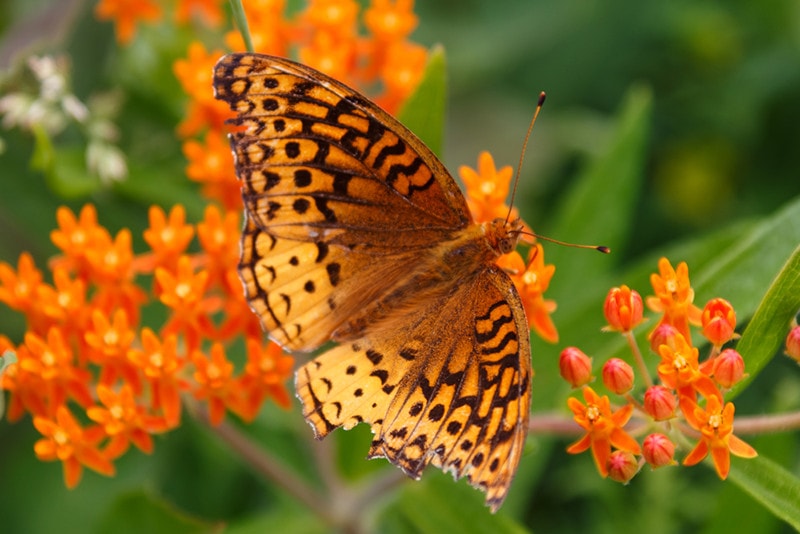
| Color | Bright yellow-orange with black webbing dots |
| Size | A wingspan of 2 to 3 inches |
| Habitat | Meadows and fields |
Aphrodite fritillary butterflies are attracted to bright flowers. They feed on the nectar and lay their eggs on the ground near them, where they hatch, and the caterpillars crawl to the violet flowers to hibernate. These butterflies are attracted to milkweed, butterfly weed, and goldenrod which are plenty in New York.
11. Common Wood-Nymph
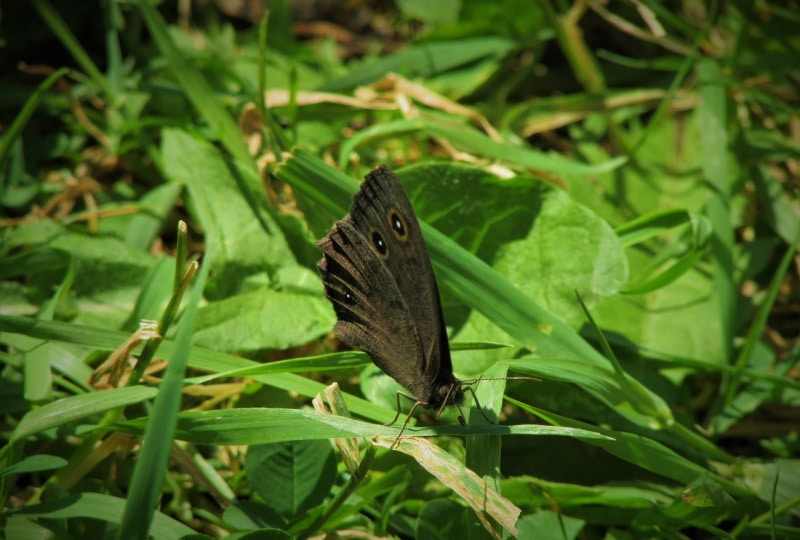
| Color | Brown coloring with dark eyespots |
| Size | A wingspan of 2 to 3 inches |
| Habitat | Open forests, salt marshes, and agricultural fields |
Common wood-nymph butterflies are found in almost all habitats within and around New York, which makes them pretty common. The eggs hatch in late fall, and the caterpillars hibernate in winter. Adult butterflies eat nectar, decaying plants, and rotting fruit. This is also the only species whose caterpillars feed on grass.
12. American Lady
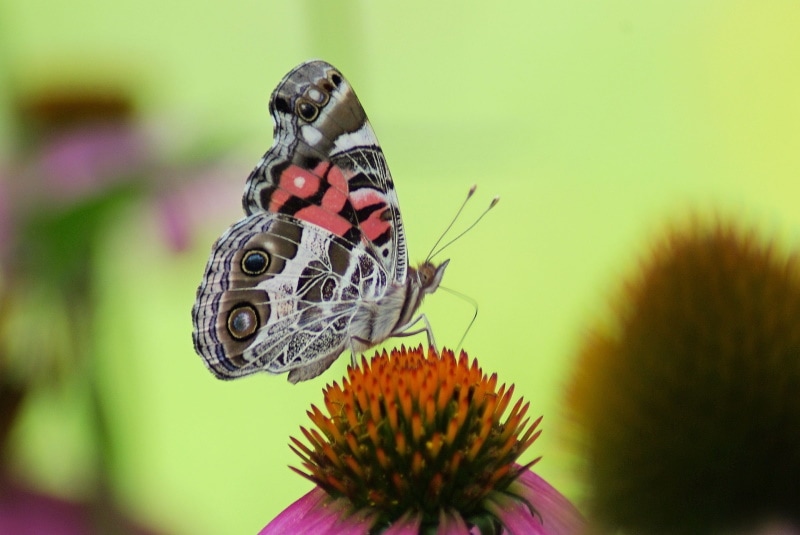
| Color | Orange coloring with dark borders with white and purple spots |
| Size | A wingspan of 1.75 to 2.5 inches |
| Habitat | Leafy flowering plants |
The most indefinable feature of this species is that it has eyespots on the underside of the wings. Eyespots are common on other insects, such as moths and even some types of fish. They intimidate predators and ward off imminent danger in their surroundings.
The American lady butterfly is nervous and will often avoid humans. They also take flight at the slightest disturbance and are, therefore, pretty hard to spot.
Why Butterflies Are Essential to the Ecosystem
Although you might not like caterpillars eating all the vegetables in your kitchen garden, butterflies play an important part in the ecosystem. Some of the benefits include:
1. Pollinating Plants
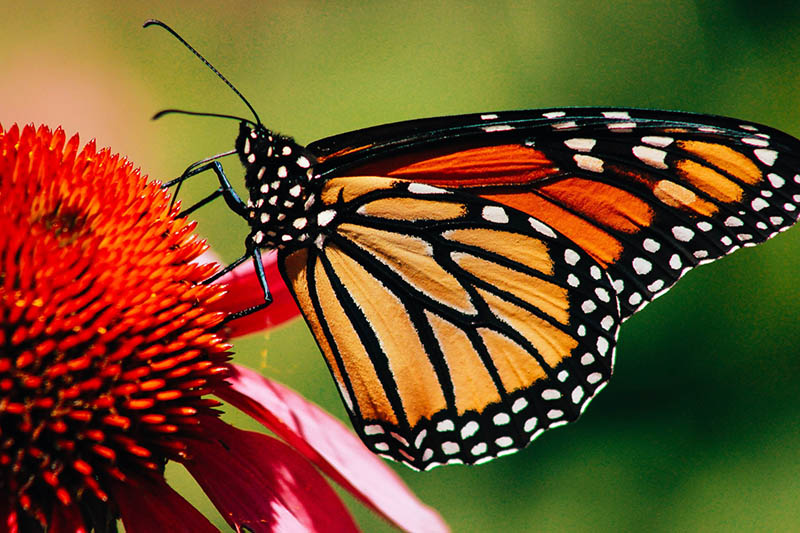
Butterflies are one of the major primary pollinators in the ecosystem. They are great for gardens since they are attracted to bright-colored flowers with nectar; when their bodies rub on the anthers of the flowers, they carry the pollen to other plants.
2. They Indicate a Health Environment
One of the key indicators that the environment/ ecosystem is healthy is the presence of insects such as bees and butterflies. Well, butterflies are great for the environment since they increase the region’s biodiversity and plants’ reproductive capability.
They are sources of food for birds, spiders, and reptiles. Bats and other small mammals also eat larvae and caterpillars. Butterflies are extremely sensitive to climate change, and a decrease in their numbers indicates a bigger effect on nature.
3. They Add to the Aesthetic
Many people enjoy butterfly-watching, and it’s not hard to see why. They are beautiful and make us happy to observe. A few moments of watching butterflies in their natural habitat can bring great pleasure to the spectators.
3 Ways We Can Protect Butterfly Populations
Butterflies are essential for a balanced ecosystem. This is why it’s unfortunate that we’re seeing a decline in species and the number of butterflies in nature. Luckily, there are several ways you can aid in preventing the decline of butterflies. They include
1. Minimize Chemical Use
Pesticides and insecticides contain chemicals that can harm and kill butterflies. Try using organic or friendly insect control methods in a region with butterflies.
2. Plant Fruits and Flowers in Your Garden
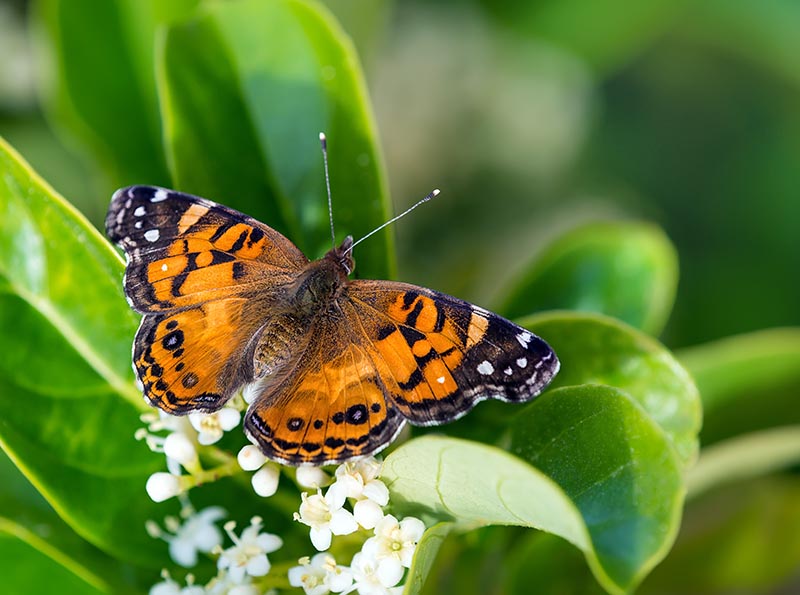
Butterflies are picky eaters and like feeding on nectar and rotten fruits, mainly citrus. Planting a variety of citrus fruits and nectar flowers in your garden ensures that food is available for the butterflies throughout the year.
3. Create a Hospitable Habitat
Butterflies love warm and moist conditions. Planting a garden with lots of bushes and small ponds encourages butterflies to lay eggs in your garden and for larvae to hatch.
Final Thoughts: Identifying Butterflies in New York
There are many butterfly watchers in New York. Most travel from other parts of the world, especially during the migration season. To identify these species correctly, consider taking a professional along with you.
If you live in New York and would like to attract butterflies to your garden or yard, try planting various flowers and plants, especially those that produce nectar. You can also place rotting fruits on several corners of your yard; however, this will also attract moths.
Featured Image Credit: gyulche1, Pixabay
Contents


